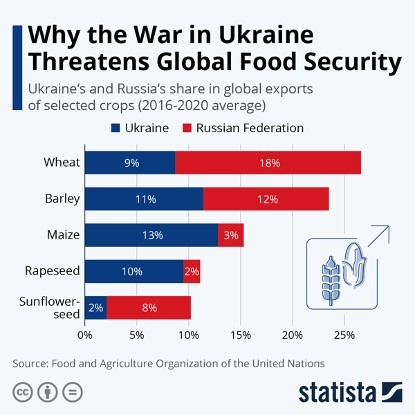2022 has come to pass with the world seeing a host of issues arising, including geopolitical conflicts, inflation, and an impending energy crisis. One of the newest matters to hit the spotlight is the challenge of food security, which has slowly been making its way across the globe.
Defining Food Security
According to a statement during the 1996 World Food Summit, food security is defined as when all people, at all times, have physical and economic access to sufficient, safe, and nutritious food that meets their dietary needs and preferences so that they can live an active and healthy lifestyle. There are four main dimensions to food security:
- The physical availability of food: This addresses the “supply side” of food security, and is determined by the level of food production, stock levels, and net trade.
- The economic and physical access to food: Having an adequate supply of food at the national or international level does not necessarily guarantee household level food security. Over time, governments concerned about insufficient food access have placed a greater policy focus on incomes, expenditures, markets, and prices in order to achieve food security objectives.
- Food utilisation: The common definition for utilisation in this context is the way the body makes the most of various nutrients. Sufficient energy and nutrient intake are the result of good care and feeding practices, the way the food is prepared, the diversity of the diet, and an intra-household distribution of food. All these factors, when combined with good biological utilisation of the food consumed, determines the nutritional status of each person.
- Stability of the three dimensions: Even if a person has adequate food intake today, they can still be considered food insecure if they have inadequate access to food on a periodic basis, because this can result in a deterioration of a person’s nutritional status. Factors such as adverse weather, political instability, or economic factors such as unemployment and rising food prices, can impact an individual’s food security status.
The Current Situation
Rising concerns about food security have plagued governments across the globe for several months now. Domestic food price inflation remains high globally, with high inflation being recorded in almost all low-income and middle-income countries from July to October this past year. In fact, 84.2% of low-income countries, 93% of lower-middle-income countries, and 93% of upper-middle-income nations have seen inflation levels jump above 5%, and many are still expecting double digit inflation to occur. Additionally, the share of high-income countries that have high food price inflation has increased to 85.5%.
In APAC specifically, food security has become a major concern; as the Russian-Ukraine war rages on and continues to disrupt supply and raise the cost of agricultural products, a report by Moody’s Investors Service predicts that food shocks could increase social discontent and trade protectionism, while policies built in response to these shocks will have long-term credit implications for sovereigns and corporates.
Specific governments that use administered prices for food fuel, and other basic commodities in Asia include India, Indonesia, Malaysia, and Thailand; according to Moody’s, this act of compensating for domestic food price increases will result in fiscal costs for governments or state-owned commodity companies. As spending pressure persists, the pace of fiscal consolidation in some of these economies will likely slow down.


Another separate factor that is affecting food security in Asia is the economic slowdown and job and income losses the region has suffered over the past two years, which has had a major impact on vulnerable countries and communities and left them more susceptible to higher commodity prices. All in all, despite Asia’s rapid economic growth and potential, this part of the world remains home to the majority of the world’s undernourished population.
The Russia-Ukraine War’s impact on food insecurity
Since the start of the war, trade-related policies imposed by countries has grown dramatically, and the global food crisis has worsened due to the increasing number of food trade restrictions implemented by countries that are looking to increase domestic supply and reduce prices. As of the end of November 2022, 19 countries have rolled out 23 food export bans, and eight have imposed 12 export-limiting measurements.
The higher food prices have in turned triggered a global crisis that is driving millions of people into extreme poverty, and has magnified the issues of hunger and malnutrition. The World Bank has reported that the COVID-19 pandemic was a major setback for global efforts to reduce poverty, and now rising food and energy prices resulting from climate shocks and conflict have stopped the recovery.

Tackling Food Insecurity – A Job for All of Us
Government policies, climate change, and geopolitical conflicts notwithstanding, the average citizen does have some options to take on the challenge of food insecurity.
1. Closing the Yield Gap
The UN Food and Agriculture Organisation estimates that by 2050, 120 million hectares of natural habitats will be converted to farming in developing nations, but the Global Landscapes Initiative at the University of Minnesota has found that current agricultural land is yielding 50% less than what it could produce. By closing the gap between what is being produced and what could be produced, the need to clear land could be reduced and up to 850 million people could be fed.
2. An efficient use of fertilizer
Today, large quantities of synthetic fertilizers are being used globally for crops; if farmers are able to reduce the use of fertilizers with nitrogen and phosphorus on wheat, rice, and maize crops by 13 – 29%, they would still produce the same yields, and they can gain further efficiency from making adjustments in the timing, placement, and type of fertilizer.
3. Raising low water productivity
In many parts of the world, water is already a major issue. By improving irrigation systems and planting crops that require less water, this issue can be resolved. In Asia, crops such as rice and sugar can demand the most water, and thus making the necessary changes will not be easy; as such, one way to encourage a move towards raising water productivity is for governments to provide economic incentives to do so.
4. Targeting food for direct consumption
Caloric efficiency can be lost when crops are converted to animal feed and other non-food uses. If these crops were instead directed towards feeding people, they could provide enough calories for 4 billion people. Potential ideas for how to make this happen include changing where certain crops are grown or encouraging small changes in diets, which could have a profound impact on this issue.
5. Lessening food waste
As a result of various factors such as inefficient preparation or inadequate storage facilities means that globally about a third of food is lost or wasted. If food wastage is reduced in three of the world’s biggest economies – the United States, India, and China, 413 million people could be fed yearly.
In the end, the issue of food security, like so many global challenges, is complex, multi-faceted, and changes depending on location, however what does not change is the fact that it is a prevalent problem, one that will shape the policies of governments and how people live for years to come. As such, it requires a multi-dimensional and multi-disciplinary approach.
Sources
- https://www.theborneopost.com/2022/07/20/food-security-becomes-a-major-concern-for-apac-governments/
- https://www.worldbank.org/en/topic/agriculture/brief/food-security-update
- https://www.worldbank.org/en/topic/agriculture/brief/food-security-update/what-is-food-security
- https://www.treehugger.com/ways-improve-global-food-security-4858809




